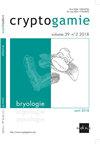人工林苔藓植物对干扰的响应波兰森林案例研究
IF 0.9
3区 生物学
Q4 PLANT SCIENCES
引用次数: 10
摘要
森林管理实践从根本上影响森林的结构(森林发展的相对年轻阶段,只有一种或两种树木占主导地位,在落叶林的栖息地种植针叶树,引进外来树种,枯木量非常有限)。苔藓植物对造林特别敏感。本研究的目的是研究特定基质对维持Murckowski森林(波兰南部西里西亚高地)苔藓物种多样性的重要性,该森林目前是一个管理森林。对100个样地的森林结构和苔藓植物在不同类型基质(地面、树底、树干和枯木)上的种类组成、频率和丰度进行了分析。共记录苔藓植物54种(苔类5种,苔藓类49种)。在枯木上观察到的物种数量最多(42),而生长在离地30 cm以上树干树皮上的典型附生植物数量最少(18)。研究证实,枯木是苔藓植物的一个重要生境,它不仅决定了苔藓植物表生物种的数量,而且决定了苔藓植物物种的整体丰富度。最大树径和老林分的存在是影响物种在树基部定殖的重要因素。本文章由计算机程序翻译,如有差异,请以英文原文为准。
Response of Bryophytes to Disturbances in Managed Forests. A Case Study from a Polish Forest
Forest management practices fundamentally impact the structure of a forest (relatively young stage of forest development, dominating stands with only one or two species of trees, planting coniferous tree species on habitats of deciduous forests, introducing alien tree species, very limited volume of dead wood). Bryophytes are especially sensitive to silvicultural practices. The aim of this study was to examine the importance of particular substrates for maintaining bryophyte species diversity in the Murckowski Forest (Silesian Upland S Poland), which is at present a managed forest. In 100 sampling plots, the structure of the forest and the species composition, frequency and abundance of bryophytes on different types of substrates (ground, tree base, tree trunk and dead wood) were analysed. In total, 54 bryophyte species were recorded (five liverworts and 49 mosses). The largest number of species was observed on dead wood (42), while the lowest number was of typical epiphytes growing on tree trunks bark more than 30 cm above the ground (18). This study confirms that dead wood is a key habitat and determines not only the number of epixylic species, but also the whole richness of bryophyte species. Maximal diameter of trees and presence of old tree stands were significant factors for species that were colonizing the tree bases.
求助全文
通过发布文献求助,成功后即可免费获取论文全文。
去求助
来源期刊

Cryptogamie Bryologie
生物-植物科学
CiteScore
2.10
自引率
25.00%
发文量
12
审稿时长
3 months
期刊介绍:
Cryptogamie is a fully electronic journal, with a continuous
publication stream, devoted to a wide diversity of cryptogamic
topics, mainly in the taxonomic-phylogenetic field.
Cryptogamie, Bryologie accepts articles on systematics as
well as ecology and evolution of all of bryophytes.
Thematic issues may also be published under the responsibility of a guest editor.
 求助内容:
求助内容: 应助结果提醒方式:
应助结果提醒方式:


